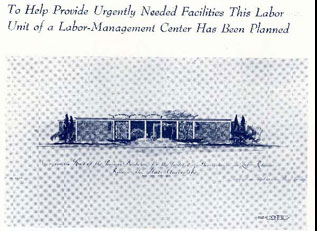
The Official Groundbreaking
for the Labor Education Center
June 20, 1959
The IMLR: Labor Education at Rutgers University, 1931–1981
by Eugene, McElroy, Library Associate, School of Management and Labor Relations
In 1997, the Institute of Management and Labor Relations (IMLR) marked its 50th anniversary. It was on June 19, 1947, that New Jersey Governor Alfred Driscoll signed into law Assembly Bill 250-A. Passed against the backdrop of the great postwar strike wave that engulfed the United States, this legislation formally established the IMLR. Its primary mission was to promote "harmony and cooperation between management and labor, and greater understanding of industrial and labor relations, thereby to enhance the unity and welfare of the people of the state." In order to carry out this assignment, the IMLR was authorized to "establish programs in order to develop new material and techniques to aid in carrying on the educational activities."
Labor education at Rutgers University predated the establishment of the IMLR by many years. Without question, Rutgers was one of the early pioneers in the field, along with such institutions as the Brookwood Labor College, the Bryn Mawr Summer School for Women, Milwaukee Labor College, and the educational extension services of the University of California. However, a precise date cannot be fixed owing to changing perspectives of what actually constituted a labor education program.
By broadly defining labor education to mean workers' education, or the entry of nonmatriculating students onto the college campus to attend university-level classes, one could point to the year 1891. In that year, the Extension Department (more commonly known as "Night School") was established at Rutgers College. Its mission was twofold: to uplift by giving nontraditional students the benefit of exposure to university-level instruction in academic (liberal arts) courses; and to generate revenue for Rutgers and the faculty who taught the courses. Ironically, the early extension curriculum offered little in the way of vocational and technical training for workers. Moreover, organized labor's aloofness to the objectives of worker's education explains why the early education extension programs developed in fits and starts. Clinging to the doctrine of "voluntarism" and economic action through collective bargaining, Samuel Gompers and the AFL remained skeptical of the university's role as a positive agent for the immediate economic and social advancement of workers—particularly in light of business ties to most institutions of higher learning. Finally, the Panic of 1893 dried up the pool of potential "working class" students.



